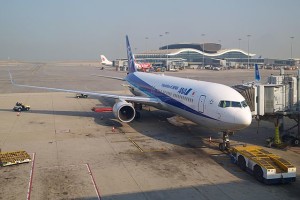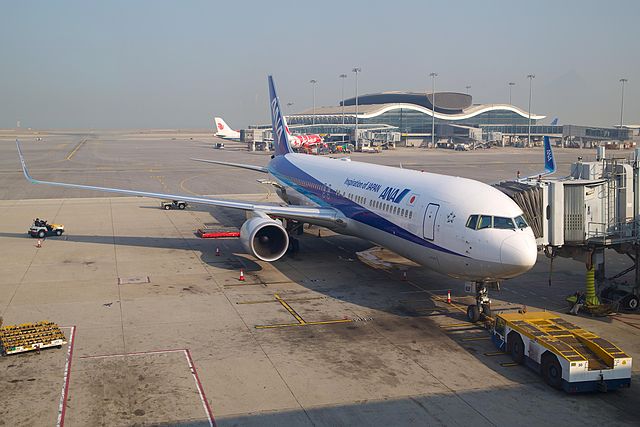 The International Air Transport Association (IATA) welcomed the Hong Kong government’s announcement that construction of the third runway at Hong Kong International Airport (HKIA) will commence next year, but suggested that funding this undertaking should not lead to higher charges.
The International Air Transport Association (IATA) welcomed the Hong Kong government’s announcement that construction of the third runway at Hong Kong International Airport (HKIA) will commence next year, but suggested that funding this undertaking should not lead to higher charges.
IATA said maintaining airport rates will ensure HKIA’s continued competitiveness even as other aviation hubs continue to rise and post a challenge.
“The announcement by the Financial Secretary [John Tsang] in his budget speech that the third runway will [have been] built by 2023 should be greeted by everyone in Hong Kong as encouraging news,” said Tony Tyler, IATA’s director general and CEO in a speech.
Establishing a three-runway system at HKIA is estimated to cost HK$150 billion (US$19.3 billion). IATA said this infrastructure can be built without increasing airline charges, burdening taxpayers, raising travelers’ expenses, or raising rates for shippers.
“Airlines fully back the user pays approach on infrastructure development. We are not asking for anyone to foot the bill for our growth. Airlines would pay for the infrastructure—through increased volumes, not increased charges. And that would apply to existing infrastructure as well as newly built facilities. The growth in traffic that the extra runway and terminal will bring will see the airport’s success over its first 17 years repeated all over again – provided its airport charges are kept competitive,” said Tyler.
Serving some 63 million travelers and processing 4.4 million tonnes of cargo makes HKIA a critical link in global connectivity, said IATA.
“Increasing HKIA’s capacity to be able to serve 100 million passengers and 9 million tonnes of cargo by 2030 will ensure that the airport continues to be a pillar of Hong Kong’s success—provided the expansion is built, financed and funded wisely,” said Tyler.
HKIA is consistently profitable, added the association. For full-year 2013-2014, HKIA had a pre-tax profit of HK$7.8 billion which is about half of revenues. It also has very little debt—just about 10% of total capital.
IATA proposes that the airport use its “advantageous financial situation” to fund its expansion through borrowing via commercial loans or bonds. The current level of charges and business model would provide sufficient revenue for loan repayment.
It pointed out that the competitiveness of Hong Kong’s air transport network is under pressure. Between 2005 and 2013 Hong Kong’s share of the market connecting China to the rest of the world shrank from 20% to 17%. It has stagnated with a 10% market share on the ASEAN-to-North America market. And its 3.3% share of ASEAN-to-Europe traffic has contracted to 2.4%.
“There are lots of reasons why these changes are happening. The Middle East airlines are proving to be strong competitors with efficient and affordable hubs being a central piece of their success. And hubs closer to Hong Kong continue to improve their offerings to enhance the competitiveness of their networks… Funding the much-needed third runway must be done in a way that does not put it at risk and which secures HKIA’s role as an economic catalyst for years to come,” said Tyler.
Cathay supports self-financing of runway
Meanwhile, Hong Kong-based carrier Cathay Pacific in a statement said that it fully supports a third runway and agrees with IATA that Airport Authority Hong Kong can build HKIA using its own funds.
Cathay Pacific chief executive Ivan Chu said: “The Airport Authority enjoys the highest net profit of any airport in the world and benefits from strong cash flows, a healthy balance sheet, and growing income from retail and aeronautical streams.
“The Airport Authority is fully capable of financing the construction of the third runway through its own means without the need to impose additional financial burden on users. Charges must remain competitive to ensure continued growth for aviation, tourism and related industries.”
Takenaka bags expansion deal for Changi Airport’s T1
As this developed, Changi Airport Group (CAG) is taking further steps to expand Changi Airport Singapore, part of its development plan for the rival hub to Hong Kong.
CAG announced recently that it has awarded a S$323-million (US$233 million) contract to Takenaka Corporation for the expansion of Changi Airport’s Terminal 1 (T1) following a competitive tender.
Takenaka, an established contractor, was involved in several of the airport’s development projects, including the ongoing construction of Terminal 4, as well as the previous upgrading of T1 in 2012 and Terminal 2 in 2006.
The works to be undertaken by Takenaka include the revamp of the T1 Departure Check-in Hall, which involves replacing existing check-in counters and installing two new check-in rows to increase passenger-handling capacity. A cluster of five retail and dining outlets located at the T1 Departure Hall will discontinue operations in the second quarter of 2015 to allow for the construction for these check-in rows.
Part of the expansion works in T1 relate to the upgrading of the T1 baggage-handling system—from a semi-automated to a fully automated system—to improve productivity for airlines and ground handlers, as well as increase check-in capacity. Two additional arrival baggage claim carousels will also be installed, further increasing the terminal’s baggage claim capacity.
To support the enhancement of the baggage-handling system, certain areas within the apron areas of T1 and the T1 Arrival Immigration Hall will be reconfigured to make space for the new system and its supporting infrastructure. The infrastructural works for the redevelopment of the baggage-handling area will be undertaken by Takenaka, while the upgrading of the baggage-handling system will be performed by Vanderlande Industries B.V.
The works at T1 by Takenaka will begin in March 2015, and are expected to be completed in 2019. These will take place alongside other redevelopment works at T1, which are being undertaken separately as part of the development of Jewel Changi Airport. These include the expansion of the floor plate of the T1 Arrival and Baggage Claim Halls, as well as the construction of new ground transport facilities and pedestrian link bridges.
Photo: Edwin





